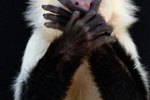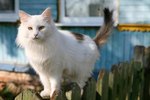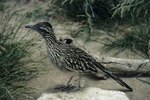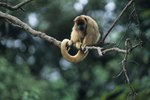
Emperor tamarin monkeys are often called mustache monkeys because their most distinctive feature is a long, drooping mustache of white hairs that stands out against their gray to black coats. They were named "emperor" tamarins because their mustaches gave them a striking and humorous resemblance to German Emperor Wilhelm II. The Amazon rain forest is the mustache monkey's natural habitat.
Geography
Mustache monkeys are indigenous to the southwest Amazon Basin. Emperor tamarins live in northwestern Brazil, northwestern Bolivia and southeastern Peru. Populations also dwell around certain river drainages in Peru. This includes the Purus and Jurua rivers, which fork off from the Amazon River, and the Acre River, which branches off the Purus. Individual groups claim territories of about 80 acres.
Habitat
Emperor tamarins primarily inhabit dense lowland and dry-bottom rainforest. They like evergreen, broadleaf and vine canopy woodlands. The setting is home to an amazing array of plant and animal life, much of which provides nourishment for mustache monkeys. It's also home to wild cats, dogs, snakes and birds of prey that hunt these primates, who weigh less than 1 pound. The mustache monkey's natural habitat has been diminishing rapidly because of logging and the clearing of land for housing and farming.
Behavior in the Habitat
Mustache monkeys are arboreal, meaning they sleep and spend most of their time in trees. They typically take up residence in trees topping out at 85 to 90 feet tall. Emperor tamarins are diurnal, or active during daylight. They generally live in packs of four unrelated individuals, usually three males and one female, but packs can range from two to 15 members. These groups actively patrol their territories, traveling with great agility through the trees, defending their turf against encroaching mustache monkeys. Though they can be bred at any time in captivity, emperor tamarins in the wild give birth between September and March.
Diet
The emperor tamarin's rich habitat provides a large and varied menu for these omnivores. Fruit is a dietary staple during the wet and dry seasons alike. Although they eat some nectar during the wet season, it is a significant part of their diet during the dry season. Other plant foods include sap, flowers and other tender vegetation. Mustache monkeys also eat many invertebrate and insect species, including larvae, ants, snails, locusts, beetles, butterflies and spiders. Their diet includes eggs and some small vertebrates, including tree frogs and lizards.
References
Photo Credits
-
Anna Kucherova/iStock/Getty Images
Writer Bio
Eric Mohrman has been a freelance writer since 2007, focusing on travel, food and lifestyle stories. His creative writing is also widely published. He lives in Orlando, Florida.




